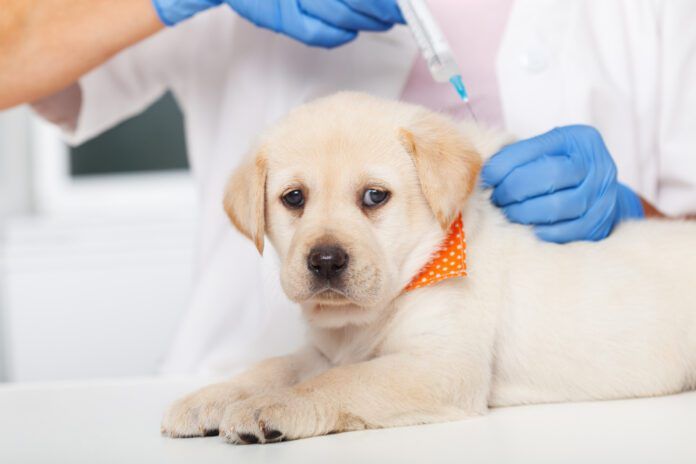“Puppy with parvo” and “puppy with distemper” are two phrases that strike fear in the hearts of dog lovers everywhere. These two puppy diseases have a high rate of mortality but are thankfully preventable with appropriate vaccinations.
Canine parvovirus, or “parvo,” causes the gastrointestinal tract to slough. Puppies with parvo have serious vomiting and diarrhea, with a characteristic foul odor to the diarrhea. (Once you smell it, you never forget the odor of parvo diarrhea; it is diagnostic.) Parvo puppies dehydrate rapidly and have little backup to compensate for the loss of incoming nutrients. While puppies with parvo can be saved, many die despite extensive and expensive supportive treatment, including immune serum and intravenous (IV) fluids.
Signs of distemper in puppies vary. A pus discharge from the eye, a cough, vomiting, diarrhea, and maybe some twitches or seizures are all possible indicators of a puppy with distemper. While these symptoms are associated with many illnesses, distemper is one of the few where all these signs can be seen in one pup. As with parvo, there is no definitive treatment. It’s supportive care. Unfortunately, puppies who pull through may be left with residual damage, such as recurrent seizures.
What’s most frustrating about parvo and distemper is that both these potentially fatal diseases are preventable with an appropriate vaccination schedule. Vaccinating puppies is tricky due to maternal antibodies. The wonderful protection from mom can interfere with puppies producing their own protective antibodies, which is why puppy vaccinations must be properly timed.
If you are lucky, your pup’s breeder did a nomograph. This information calculates when maternal antibodies will wear off for parvo and distemper based on the dam’s own titers. That way you know when you need to start your pup’s vaccination series. It might be as early as 6 weeks of age for parvo only if the dam is a nonresponder or you might be able to wait until 12 weeks old for the first in a series of two. Without that knowledge, most protocols suggest starting when the puppy is 8 weeks old and giving another dose at 12 and 16 weeks.
Kennel cough in puppies is slightly more complicated. Many different pathogens can cause the canine cough syndrome. These range from the benign parainfluenza virus, the bacteria Bordetella, and to the dangerous canine flu virus. While distemper and parvo are fairly ubiquitous, puppies need exposure to a coughing or sick dog to come down with a cough. Which vaccines are relevant for your puppy varies with his potential exposures. The American Animal Hospital Association (AAHA) has a cool link that helps you determine the right vaccinations for your puppy.
With milder forms of kennel cough in puppies, symptomatic care is often all they need. Usually, your puppy will sound worse than he feels. If this progresses to pneumonia, however, it becomes more serious. At that point, antibiotics for secondary bacteria, fluids to maintain hydration, and possible time in an oxygen cage may be necessary.
Leptospirosis in puppies is not common unless your pup has frequent exposures to water sources frequented by wildlife or vermin, like city rodents. Sniffing infected urine is also a possible point of infection. If your pup does get leptospirosis, it is very serious with potential permanent damage to his kidneys and/or liver. First signs are usually fever, pain, a reluctance to move, and generally some vomiting or diarrhea. Treatment is antibiotics, often with concurrent fluid therapy.
Leptospirosis is not considered a core vaccine—core vaccines are the ones recommended for all dogs—but your veterinarian can advise you about risks in your area and based on your pup’s lifestyle.
The bottom line is that a sensible vaccination program can keep your pup safe from the worst common illnesses in puppies. Plan the right schedule for your pup with your veterinarian.





